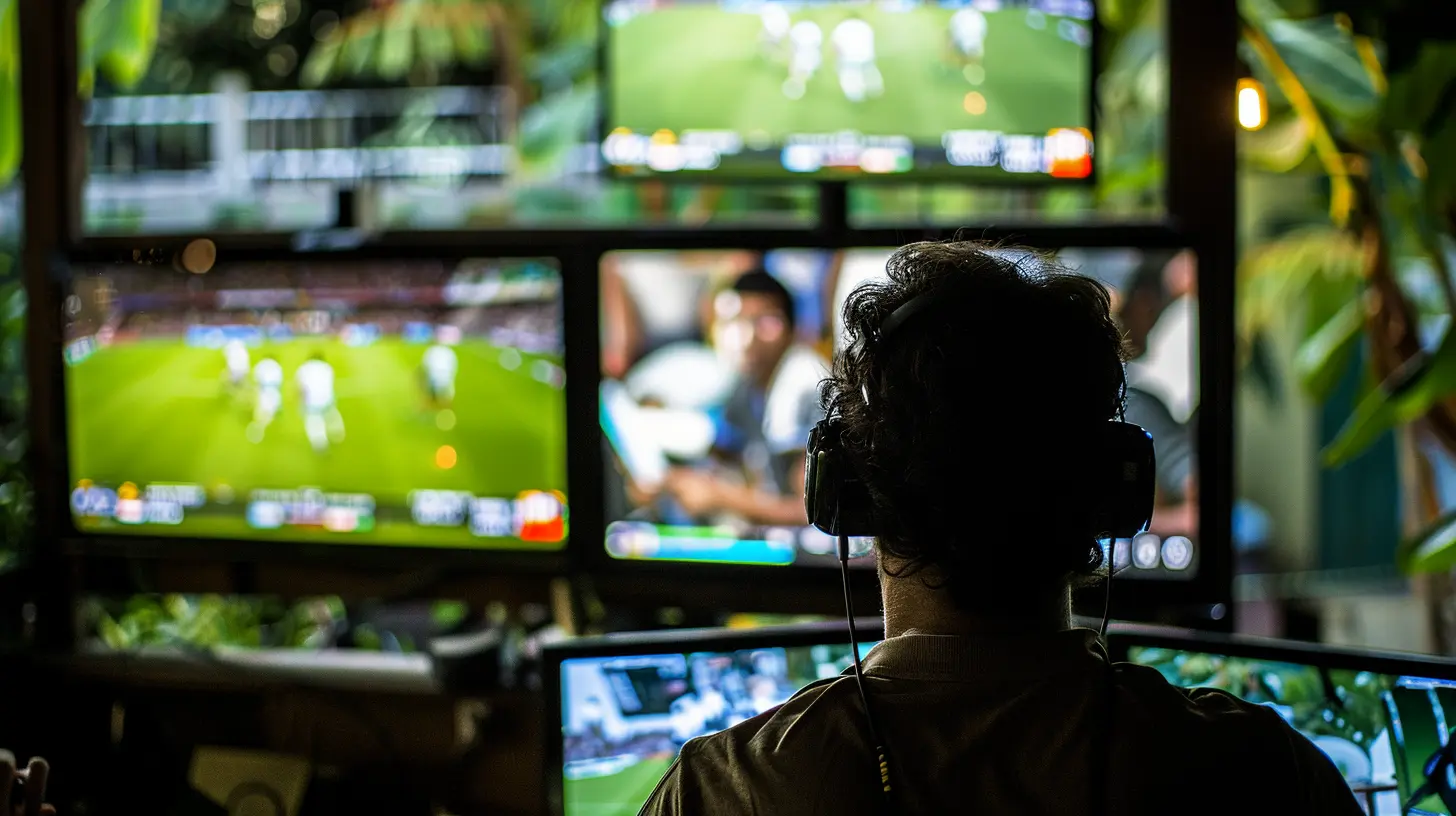Boosting Your Sports Streaming Quality: What You Need to Know
20 April 2025
Sports streaming – it’s how most of us catch our favorite games these days. Whether we’re watching the Super Bowl, Wimbledon, or our local team's matches, there’s nothing worse than buffering, poor picture quality, or audio cutting out right when the tension is highest. You’re yelling at your screen, but deep down, you know it’s not the player’s fault—it’s your streaming quality. We've all been there, right?
So, how can you ensure you’ve got the best streaming experience without the annoying buffering wheel ruining the moment? Well, you're in the right place. In this article, we’ll break down everything you need to know to boost your sports streaming quality and make sure you never miss another winning moment!

Why Streaming Quality Matters for Sports
Before diving into the technical details, let's talk about why streaming quality is such a big deal when it comes to sports.Sports are fast-paced. Every second counts. A slight delay or blur during a crucial moment—like a goal, touchdown, or knockout punch—can ruin the entire experience. Unlike movies or TV shows, where buffering may just interrupt dialogue or a scenic view, poor streaming quality in sports could mean missing out on the action entirely.
If you’re serious about sports, then you should be serious about your streaming quality. After all, you want to feel like you’re right there in the stadium, don’t you?

1. Internet Speed: The Foundation of Good Streaming
Let’s cut to the chase: internet speed is the cornerstone of seamless streaming. Without a solid connection, even the best streaming service will struggle.What Kind of Speed Do You Need?
The good news is that most streaming platforms give you a guideline on the speeds required for different levels of quality:- Standard Definition (SD): 3 Mbps
- High Definition (HD): 5-8 Mbps
- 4K (Ultra HD): 25 Mbps or higher
But here’s the catch—those numbers are "minimum" requirements. If you’ve got family members streaming other content or you're using other devices on the same network, you may need more bandwidth.
Test Your Speed
Before you go calling your internet provider, run a quick speed test. There are tons of free speed test tools available online (just Google "internet speed test"). If you’re not hitting the recommended speeds, you might need to talk to your ISP about upgrading your plan.Pro tip: Ethernet cables can offer a more stable connection than Wi-Fi. If possible, plug your device directly into your router for a more reliable experience.

2. Streaming Device Matters
Not all devices are created equal when it comes to streaming sports. Your smartphone, laptop, smart TV, or streaming box all have different capabilities. And, believe it or not, the device you use can significantly impact your streaming quality.Smart TVs and Streaming Devices
If you’re watching on a smart TV, make sure you have one capable of handling HD or 4K streams. For older TVs, pairing them with a streaming device such as a Roku, Amazon Fire Stick, or Apple TV can drastically improve your experience.Mobile vs. Desktop
Watching on your phone? It’s convenient, but mobile networks can be hit or miss. On the other hand, streaming on a desktop or laptop offers a better chance of maintaining a stable connection, especially if you're using a wired connection.
3. Choose the Right Streaming Service
Not all streaming platforms are built the same. The platform you choose can make or break your viewing experience.Look for Reliable Platforms
Some streaming services are known for their excellent quality, while others are plagued with buffering and lag. When selecting a service, consider well-known platforms like:- ESPN+: Great for a variety of sports, from the NFL to UFC.
- DAZN: Specializes in fight sports like boxing and MMA.
- FuboTV: Known for its extensive sports coverage.
- YouTube TV: Offers a good balance of sports and entertainment channels.
These services usually offer better reliability, and, more importantly, they adjust their streaming quality based on your internet speed. This ensures you're always watching at the best possible quality, given your current bandwidth.
Free Services? Beware!
We all love free stuff, but free sports streaming services can be a gamble. Many of these platforms suffer from poor video quality, constant interruptions, and even legal issues. If you’re serious about your sports, it’s worth investing in a paid subscription.4. Optimize Your Wi-Fi
Now, let’s talk about your Wi-Fi. Even if your internet speed is top-notch, poor Wi-Fi setup can still cause lag and buffering.Position Your Router Correctly
The placement of your router can significantly impact your streaming quality. Aim to position it in a central location in your home, ideally elevated and away from thick walls or metal objects that can interfere with the signal.Reduce Interference
Other devices, like microwaves, baby monitors, and even Bluetooth devices, can interfere with your Wi-Fi signal. Try to reduce the number of active devices or switch to a less congested Wi-Fi channel if possible.Consider a Wi-Fi Extender or Mesh System
If you have a large home or multiple floors, a Wi-Fi extender or mesh network can help eliminate dead zones. These devices ensure a strong internet signal throughout your home, so you’re less likely to experience lag while streaming in another room.
5. Adjust Streaming Settings
Sometimes, the easiest way to improve your streaming quality is to adjust the settings within the app or platform you’re using. Most services offer an option to manually adjust the quality of the stream.Lowering Quality to Reduce Buffering
If your internet connection is struggling, it’s better to lower the video quality than deal with constant buffering. Most platforms give you the option to switch between SD, HD, and 4K. If buffering is becoming an issue, try dropping the stream to HD or even SD.6. Consider a VPN for Better Access
Here’s something you might not have thought of: using a VPN (Virtual Private Network) can sometimes improve your streaming quality.How a VPN Can Help
Some ISPs throttle your internet speed when they detect you're streaming video. A VPN can hide your activity, preventing throttling and ensuring you get the full speed you’re paying for.Additionally, a VPN can give you access to sports streams that might be restricted in your region. For example, if a game is blacked out in your area, a VPN can let you bypass the restriction by making it look like you're streaming from a different location.
Choose a High-Speed VPN
Not all VPNs are created equal. Some can actually slow down your internet connection, making your streaming experience worse. To avoid this, choose a VPN that’s optimized for speed, such as ExpressVPN, NordVPN, or Surfshark.
7. Keep Your Software Updated
This might sound like a no-brainer, but keeping your apps and devices updated can make a big difference. Streaming platforms are constantly improving their apps to offer better performance and fix bugs. If you’re using an outdated version, you might be missing out on these improvements.The same goes for your device's operating system. Whether it’s your smart TV, phone, or streaming box, keeping software up-to-date ensures you’re using the most optimized version.
8. Buffering Issues? Try Restarting
When all else fails, the good old-fashioned restart can often fix streaming issues. Whether it’s your router, your streaming device, or the app itself, restarting can clear out any temporary hiccups causing poor performance.
9. Data Caps: The Hidden Culprit
One sneaky reason for poor streaming quality that many people overlook? Data caps. Some internet providers limit the amount of high-speed data you can use each month. Once you hit your cap, your speed is throttled, and your streaming quality takes a nosedive. If your ISP imposes data caps, consider switching to a provider that offers unlimited data.Final Thoughts
There you have it! Boosting your sports streaming quality doesn’t have to be a headache. By taking a few simple steps—like upgrading your internet, optimizing your Wi-Fi, and choosing the right streaming service—you can ensure that you’re getting the best possible experience every time you catch a game.Remember, every second counts when you’re watching sports. Don’t let lag, buffering, or poor quality ruin the excitement. Take control of your streaming setup, and you’ll be celebrating your team’s victories in crystal-clear HD (or 4K) in no time.
all images in this post were generated using AI tools
Category:
Live StreamingAuthor:

Nelson Bryant
Discussion
rate this article
6 comments
Maggie Barnes
Absolutely loved this article! Streaming sports just got a major upgrade! 🎉 Those tips are game-changers for enjoying every thrilling moment without interruptions. Can’t wait to implement these strategies and cheer on my favorite teams in the best quality possible! Go, team! 🏆📺
May 17, 2025 at 2:35 AM

Nelson Bryant
Thank you so much! I’m glad you enjoyed the article and found the tips useful. Happy streaming and cheering for your teams! 🏆📺
Ulrich McLain
Streaming woes? It’s time to level up! Don’t settle for pixelated plays—get your gear in check and elevate that viewing experience!
April 30, 2025 at 6:53 PM

Nelson Bryant
Absolutely! Upgrading your gear is essential for a seamless streaming experience. High-quality equipment can make a significant difference in picture clarity and overall enjoyment.
Natalie McKibben
This article aptly highlights the importance of optimizing streaming quality for sports fans. However, it could delve deeper into the impact of internet speed, hardware upgrades, and potential subscription pitfalls. As live events are time-sensitive, emphasizing these factors would enhance user experience and prevent frustrating interruptions during crucial moments.
April 27, 2025 at 4:44 AM

Nelson Bryant
Thank you for your insightful feedback! I appreciate your suggestions and will consider incorporating a deeper exploration of internet speed, hardware, and subscription challenges in future updates to enhance the article.
Roxie Simon
Absolutely loved this article! Streaming sports has never been smoother. Thanks for sharing these helpful tips to enhance our viewing experience. Can’t wait to enjoy my favorite games in high quality – let the fun begin! 🎉🏆
April 23, 2025 at 4:33 AM

Nelson Bryant
Thank you! I’m glad you enjoyed the article and found the tips helpful. Enjoy your games! 🎉🏆
Kenzie McDonald
Why watch a game in standard definition when you can see every bead of sweat? Upgrade your streaming and get ready for the ultimate couch-side experience!
April 22, 2025 at 7:55 PM

Nelson Bryant
Upgrading your streaming quality truly enhances the viewing experience, allowing you to catch every detail and feel more immersed in the action!
Dusk Sharp
Great tips! Upgrading your internet and device makes a huge difference in streaming quality.
April 21, 2025 at 2:24 AM

Nelson Bryant
Thank you! Upgrading your internet and device can really enhance the streaming experience. Glad you found the tips helpful!
MORE POSTS

The History of Professional Boxing: From Bare-Knuckle Brawls to Modern Legends

How Fan Podcasts Are Shaping the Conversation Around Sports

How to Improve Your Internet for Better Live Sports Streaming

Yoga for Swimmers: Enhancing Breath Control and Flexibility

Strategic Mastery: A Lesson in How to Win the Big Games